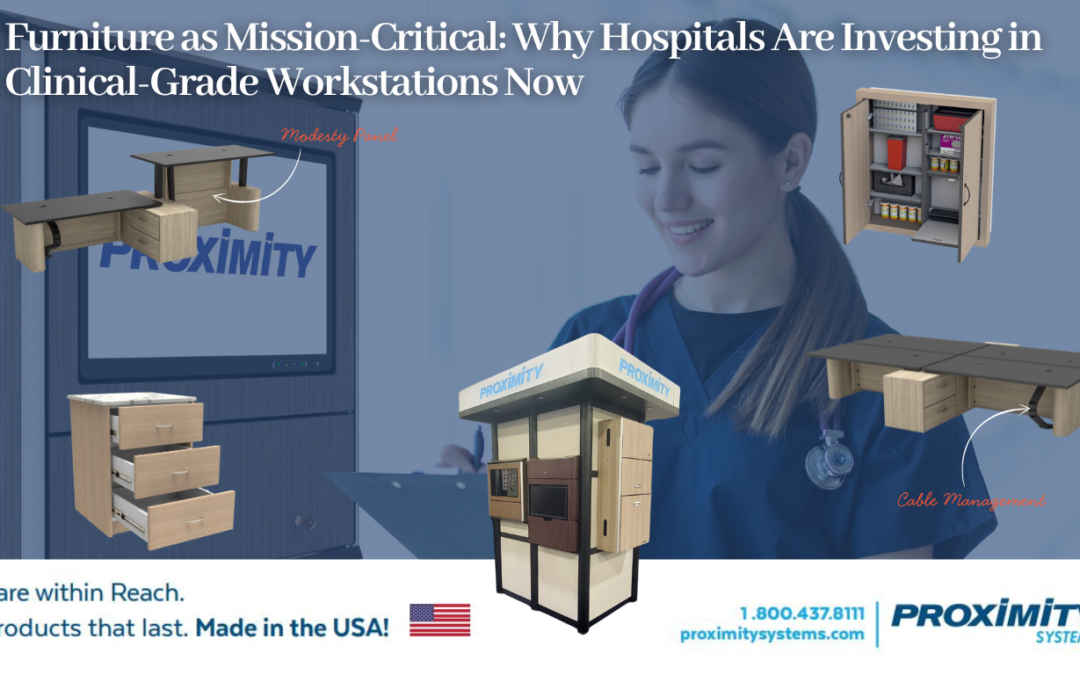Introduction
Hospitals and care facilities are dealing with a perfect storm of pressures: aging populations, expanding chronic-care needs, tighter infection-control regulations, and rising expectations from patients and staff alike. What was once considered background infrastructure — the furniture — is now stepping into the spotlight.
Modern facilities aren’t just purchasing new chairs or sprucing up waiting areas; they’re re-engineering entire workspaces. And that means investing in clinical-grade furniture, workstations, and enclosures that deliver on hygiene, ergonomics, and workflow integration.
According to recent market data, the global healthcare-furniture market was valued at approximately US $7.94 billion in 2024 and is projected to reach US $11.73 billion by 2033, growing at a compound annual rate of 4.38 % (IMARC Group). Another report estimates the broader “medical furniture” category could reach US $20.7 billion by 2034, doubling from 2024 values (Precedence Research).
These numbers tell a clear story: furniture is no longer an afterthought — it’s a strategic asset in healthcare design.
The Market Drivers Behind the Shift
1. Demographics & Care Models
An aging population and rising chronic conditions are reshaping care delivery. Hospitals, outpatient centers, and long-term-care facilities are expanding — and they require adaptable, durable furniture that supports patient and clinician needs across multiple care settings.
2. Infrastructure Modernization
Hospitals are undergoing large-scale renovation and modernization projects. As competition for patients and staff intensifies, aesthetics, safety, and usability are now part of each facility’s brand experience. Furniture that combines design appeal with infection control is a differentiator.
3. Ergonomics & Staff Well-Being
Clinicians are standing, sitting, and moving constantly. Poorly designed workstations can contribute to fatigue and repetitive-strain injuries. Ergonomic solutions — like Proximity Systems’ Ascende sit-stand desks and E5 monitor-arm systems — reduce strain and improve comfort during long shifts.
4. Hygiene & Infection Prevention
Furniture is now viewed through the same lens as medical equipment when it comes to hygiene. Non-porous, easy-to-clean, and antimicrobial surfaces are becoming mandatory. Every surface and joint matters in protecting patients and staff from hospital-acquired infections (HAIs).
5. Workflow & Technology Integration
The rise of telehealth, digital records, and mobile devices means workstations must seamlessly accommodate IT infrastructure while maintaining infection-control standards. Furniture is now part of the digital ecosystem — not separate from it.
Why This Matters for Proximity Systems
At Proximity Systems, we’ve spent years designing and manufacturing antimicrobial, ergonomic, secure workstations and enclosures that directly address these industry shifts.

Our U.S.-made solutions combine infection-control materials, ergonomic adaptability, and secure technology integration, empowering healthcare teams to work smarter and safer.
From Ascende sit-stand desks to E5 monitor-arm systems and wall-mounted enclosures, each product is engineered to reduce cleaning time, support mobility, and withstand the realities of high-touch environments.
Hospitals are no longer asking, “Does this look nice?” They’re asking, “Will this protect our people, streamline our workflow, and secure our technology?”
That’s the question Proximity Systems is built to answer.
Furniture as ROI and Risk Mitigation
Traditionally, furniture purchasing has been treated as a cost center. Today, leading healthcare organizations are reframing it as a strategic investment.
When ergonomic and antimicrobial furniture reduces staff injuries, cleaning labor, and infection risk — the return on investment becomes measurable.
- Reduced downtime from musculoskeletal injuries.
- Lower costs associated with infection events.
- Improved staff satisfaction and retention.
- Better patient perception of care environments.
Clinical-grade furniture is not just about comfort — it’s about care quality, safety, and operational efficiency.
Action Steps for Healthcare Decision-Makers

- Audit your current furniture: Are your workstations, enclosures, and arms compliant with today’s hygiene and ergonomic standards?
- Design for integration: Make sure your workstations accommodate both staff movement and technology use.
- Prioritize cleanability: Materials should resist microbes and withstand daily disinfection.
- Specify for longevity: Choose products with durable construction, long warranties, and modular design for upgrades.
- Partner with experts: Work with a manufacturer that understands healthcare workflow, not just commercial furniture.
The Takeaway
The clinical-grade furniture market may not make daily headlines, but it’s quietly transforming healthcare infrastructure. With billions of dollars in projected growth, evolving care models, and stricter infection-control standards, the message is clear:
Furniture isn’t just furniture anymore — it’s part of patient safety, staff wellness, and operational success.
At Proximity Systems, we’re proud to build solutions that unite form, function, and safety — helping healthcare facilities create smarter, cleaner, more human-centered workspaces.
Call to Action
🔧 Ready to rethink your clinical furniture strategy? Contact Proximity Systems today to explore how our antimicrobial, ergonomic, and secure workstations and enclosures can elevate your facility’s design and workflow.
📍 Corporate Head Office: 11301 Boudreaux Rd, Tomball, TX 77375, USA
📞 Phone: +1 (800) 437-8111
📧 Email: sales@proximitysystems.com
🌐 Website: www.proximitysystems.com
✅ Schedule a live virtual demo with our product team.
